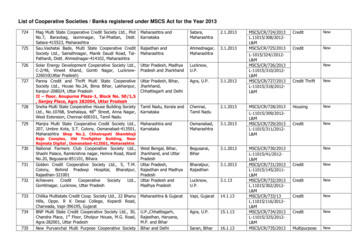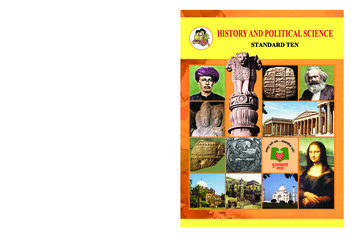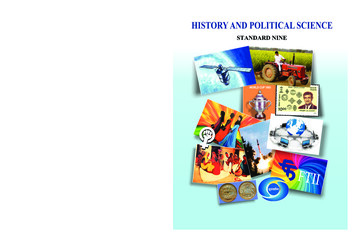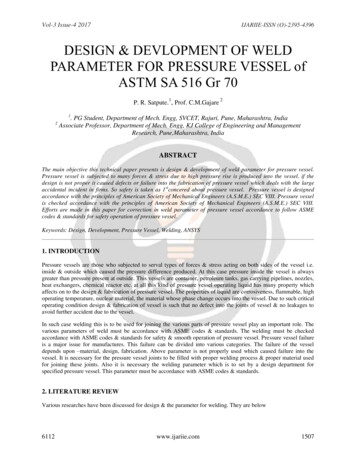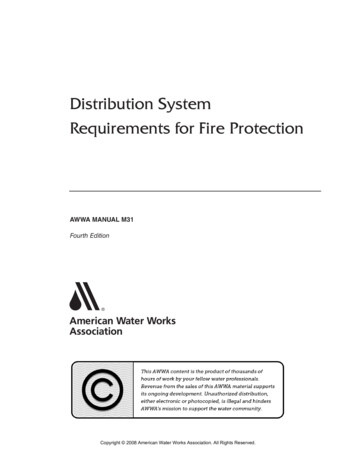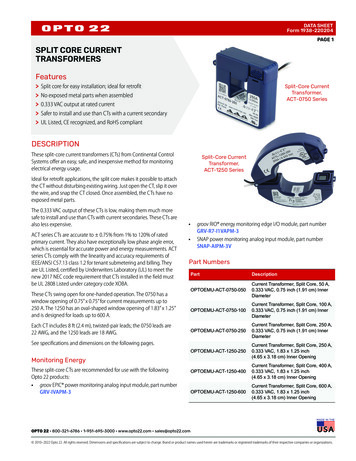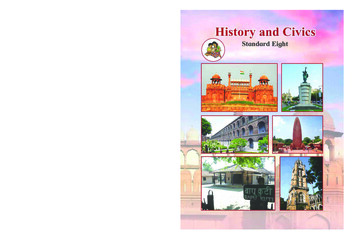
Transcription
IIStandard Eight-Maharashtra State Bureau of Textbook and Curriculum Research, Pune.t 42.00I I-
The Coordination Committee formed by GR No. Abhyas - 2116/(Pra.Kra.43/16) SD - 4Dated 25.4.2016 has given approval to prescribe this textbook in its meeting held on29.12.2017 and it has been decided to implement it from the educational year 2018-19.History and CivicsStandard EightMaharashtra State Bureau of Textbook Production andCurriculum Research, Pune - 411004.The digital textbook can be obtained throughDIKSHA App on a smartphone by using theQ.R Code given on title page of the textbook anduseful audio-visual teaching-learning material ofthe relevant lesson will be available through theQ.R Code given in each lesson of this textbook.
First Edition : 2018 Maharashtra State Bureau of Textbook Production and CurriculumResearch, Pune - 411 004.The Maharashtra State Bureau of Textbook Production and Curriculum Research reservesall rights relating to the book. No part of this book should be reproduced without the writtenpermission of the Director, Maharashtra State Bureau of Textbook Production and CurriculumResearch, ‘Balbharati’, Senapati Bapat Marg, Pune 411004.History Subject CommitteeWriting GroupDr. Sadanand More, ChairmanShri. Mohan Shete, MemberShri. Pandurang Balkawade, MemberDr. Shubhangana Atre, MemberDr. Somnath Rode, MemberShri. Bapusaheb Shinde, MemberShri. Balkrishna Chopde, MemberShri. Prashant Sarudkar, MemberShri. Mogal Jadhav, Member-SecretaryShri. Rahul PrabhuProf. Shivani LimayeShri. Bhausaheb Umate Shri. Sanjay VazrekarShri. Prashant Sarudkar Prof. Sadhana KulkarniTranslationDr. Priya GohadProf. Ajinkya GaikwadScrutinyDr. Ganesh RautDr. Vaibhavi PalsuleCover and IllustrationsCivics Subject CommitteeShri. Dilip KadamDr. Shrikant Paranjape, ChairmanProf. Sadhana Kulkarni, MemberDr. Prakash Pawar, MemberProf. Ajinkya Gaikwad, MemberProf. Sangita Aher, MemberDr. Mohan Kashikar, MemberShri. Vaijnath Kale, MemberShri. Mogal Jadhav, Member-SecretaryCarteographerHistory and Civics Study GroupShri. Rahul PrabhuShri. Vishal KulkarniShri. Sanjay Vazarekar Shri. Shekhar PatilShri. Subhash RathodShri. Ramdas ThakarSmt Sunita DalviDr. Ajit ApteProf. Shivani LimayeDr. Mohan KhadseShri. Bhausaheb Umate Smt Shivkanya KaderkarDr. Nagnath YevaleShri. Gautam DangeShri. Sadanand Dongre Dr. Vyankatesh KharatShri. Ravindra PatilShri. Ravindra JindeSmt Rupali GirkarDr. Prabhakar LondheDr. Minakshi Upadhyay Dr. Manjiri BhaleraoDr. Raosaheb ShelkeDr. Satish ChapleProf. Shashi NighojkarShri. Ravikiran JadhavTypesettingDTP Section, BalbharatiPaperPrint OrderPrinter:::70 GSM CreamwoveN/PB/2018-19/75,000M/s. SPENTA MULTIMEDIA PVT. LTD. ,THANECoordinationMogal JadhavSpecial Officer, History and CivicsVarsha SarodeSubject Assistant, History and CivicsProductionSachchitanand AphaleChief Production OfficerPrabhakar Parab,Production OfficerShashank Kanikdale,Asst. Production OfficerPublisherVivek Uttam Gosavi, ControllerMaharashtra State Textbook Bureau,Prabhadevi, Mumbai - 400 025.
NATIONA ANT
PrefaceDear Students,From standard III to standard V you have studied the subjects of historyand civics in ‘Environmental Studies’. In the syllabus of standard VI onwardshistory and civics are independent subjects. From standard VI onwards both thesesubjects are included in one textbook. We are happy to place this textbook ofstandard VIII in your hands.The structure of the textbook is designed with the objective that the subjectshould be properly understood, felt interesting and get inspired by the work doneby our ancestors. By studying this textbook we hope that along with knowledgeyour learning will also become meaningful. For this purpose coloured pictures,maps are given in the textbook. Every chapter of the textbook should be studiedattentively. Those parts which are difficult to understand can be explained byyour teachers and parents. The content given in the table will increase yourcuriosity. If you want to know more, then through the medium of App usingthe QR code useful audio visual material related to the chapter will be availableto you. It will definitely be useful for your study. An attempt is made to makehistory interesting and it will surely develop within you a liking for the subject.The history part deals with Modern Indian History. The textbook is writtenby combining new trends in history and core values of national education.By studying the textbook it will be clear as to how the principles of liberty,equality, fraternity, and justice evolved in the history of Modern India. There isan introduction to sources of history of Modern India in the textbook. Similarlyan overview of the expansion of British rule in India is taken. Information aboutthe unforgettable fight given by the Indian people to free India from the chainsof British rule is given in the part of history.In the part of civics an introduction to Parliamentary Government Systemis given. It tells that the working of our country is based on constitution, lawsand rules. Indian Parliament, Central Legislative Assembly, Judicial system ofIndia, working of State government, Bureaucratic structure and their role in theprocess of democracy is made clear in this textbook.PuneDate : 18 April 2018, Akshaya TritiyaIndian Solar Date : 28 Chaitra 1940Dr. Sunil MagarDirectorMaharashtra State Bureau of TextbookProduction and Curriculum Research, Pune
For the TeachersWe have studied ancient and mediaeval history of India in the syllabus of Standard VIand VII respectively. History syllabus of Standard VIII includes the process of colonialisationand decolonialisation in India as well as the Samyukta Maharashtra Movement in postindependence period. Due to the study of intellectual inspiration behind the freedom struggle,rise and development of Nationalism in India and the contribution of freedom fighters, thesense of responsibility towards Nation and patriotism among students will increase.History is a scientific subject in which sources of history are exceptionally important.While considering the changing nature of sources of history as per the time period, the sourcesof history are included in the first unit. There was growth of imperialism in Europe due to theage of Renaissance and revolution which led to the growth of the process of colonialisation inAsian and African continents. We are going to think about how India fell prey to the westernimperialist ambition, what were the effects of British rule over India, later how did the Indiansdevelop a sense of Identity and attained inspiration of independence.While teaching the Indian freedom struggle a complete information of events such asfreedom struggle of 1857, establishment of Indian National Congress, work of Indian NationalCongress in the moderate and extremist phase, the Satyagrahi movements during Gandhi era,armed revolutionary movement, struggle of Indian National Army, independence of India,integration of princely states, liberation of French and Portuguese colonies can be providedto the students through the medium of audio visual sources (films, documentaries, recordingsetc.), field visits, exhibitions, newspapers etc.While thinking about the political events, the students can be introduced to how thechanges in social and economic fields of India took place, how the thought of social andeconomic equality was inculcated among the Indians. While studying the background of Indianhistory we have to consider the events in the formation of state of Maharashtra and theSamyukta Maharashtra Movement.In the part of Civics of Standard VII we have studied the philosophy, values expressedthrough the Constitution. In standard VIII the system of government created by constitution,administrative system, judicial machinery and judicial system is thought about. The relevantcontent should be taught with the help of contemporary events. It should be associated withthe philosophy of constitution and the values and ideals reflected through it.The students should be made aware that Constitution is a living document through whichdemocracy and suzeranity of law comes into reality. It will help the students to be morematured in social and economic consciousness. It will be possible for the students to findthe relation between democratic Institutions and various political processes. On basis of thecontents given in the textbook, activities like discussions, group discussions, projects, posters,understanding different political facets based on a single subject can be done from the students.While designing the textbook constructive education and activity based teaching is givenspecific importance. For this purpose additional and interesting information related to thechapter is given in tabular format. Along with it through let us discuss, do it etc. how thestudent will remain active in the learning process is thought about. With a view to give scopeto the action, thought and self expression, the self study and project is designed. For providingadditional sufficient information regarding the chapter the QR code is included in the textbook,by using it effective teaching will be easier for you.
History(History of Modern India)INDEXS.No.Name of the ChapterPage No.1.Sources of History.12.Europe and India.53.Effects of British rule.104.The Freedom Struggle of 1857.155.Social and Religious Reforms.216.Beginning of Freedom Movement.257.Non-co-operation Movement.318.Civil Disobedience Movement.369.Last Phase of Struggle for Independence.4010.Armed Revolutionary Movement.4511.Struggle for Equality.5012.India gains Independence.5613.Fulfillment of Struggle for Independence.5914.Formation of State of Maharashtra.62S.O.I. Note : The following foot notes are applicable : (1) Government of India, Copyright : 2018. (2) The responsibility for thecorrectness of internal details rests with the publisher. (3) The territorial waters of India extend into the sea to a distance of twelvenautical miles measured from the appropriate base line. (4) The administrative headquarters of Chandigarh, Haryana and Punjab areat Chandigarh. (5) The interstate boundaries amongst Arunachal Pradesh, Assam and Meghalaya shown on this map are as interpretedfrom the “North-Eastern Areas (Reorganisation) Act. 1971,” but have yet to be verified. (6) The external boundaries and coastlines ofIndia agree with the Record/Master Copy certified by Survey of India. (7) The state boundaries between Uttarakhand & Uttar Pradesh,Bihar & Jharkhand and Chattisgarh & Madhya Pradesh have not been verified by the Governments concerned. (8) The spellings ofnames in this map, have been taken from various sources.
Learning OutcomesSuggested Pedagogical ProcessesTo give opportunities to study Individually orin the group of two or more and to motivatethe students in undertaking following activitiesLearning OutcomesStudents Understand various sources of History and Raise questions on different issues andevents like ‘Why the British East IndiaCompany felt it necessary to involveitself in the internal hereditary feudsamongst the Indian rulers ?’ Visitplaces of historical importanceparticularly those associated with centresof colonial administration and Indiannational movement. Gandhiji’s idea of non violence and itsimpact on India’s national movement, Drawing up a timeline on significantevents of India’s national movement, Enacting a role play on the Chauri Chaura incident, Locating on an outline map of India, ‘theregions most affected by commercial cropcultivation during the colonial period’,undertaking of such such projects andactivities. Familiarisewith the sources likevernacularandBritishaccounts,autobiographies, biographies, novels,paintings, photographs, contemporarywritings, documents, newspaper reports,films, documentaries and also recentwritings to understand and reconstructhistories of various movements. Expose to pedagogically innovative andcriterion-referenced questions for selfassessment like ‘What are the causes ofBattle of Plassey?’ clarify its use in rewriting the history of thisperiod.Distinguishes ‘the modern period’ from the‘mediaeval’ and the ‘ancient’ periodsthrough the use of sources, nomenclaturesused for various regions of the Indian subcontinent and the historical events that tookplace in the particular period.Explains how the East India Companybecame the most dominant power.Explains the differences in the impact ofcolonial agrarian policies in differentregions of the country like the ‘Indigorebellion’.Describes the forms of different tribalsocieties in the 19th century and theirrelationship with the tiontowardsthetribalcommunities.Explains the origin, nature and spread ofthe freedom struggle of 1857 and the lessonslearned from it.Analyses the decline of pre-existing urbancentres and handicraft industries and thedevelopment of new urban trade centresand industries in India during the Britishrule.Explains the institutionalisation of the neweducation system in India.Analyses the issues related to caste, women,widow remarriage, child marriage, socialreforms and the laws and policies of Britishadministration towards these issues.Outlines major developments that occuredduring the modern period in the field of arts.Outlines the course of the Indian nationalmovement from the 1870 till independence.Analyses the significant developments inthe process of nation building.
1. Sources of HistoryWe have studied the sources ofancient and mediaeval Indian history.This year we are going to study thesources of Modern Indian History.Historical sources include material, writtenand oral sources. Similarly sources basedon modern technology such as audio,video and audio-visual are included.Do you know ?Museums and History :Forthe study of History various objects,paintings, photographs and suchother things are preserved in amuseum. At the Aga Khan Palacein Pune, we can see different objects,documents giving information aboutthe life of Mahatma Gandhi.Material Sources : Various objects,monuments, places, coins, sculptures etc.can be included in the material sourcesof history.Buildings and Places : The period ofModern Indian History is believed asperiod of European, especially the Britishrulers, and governance of Princely States.In this period various buildings, bridges,roads, water supply system, fountains etc.were built. These buildings includegovernment offices, residences of officers,leaders and revolutionaries; palaces ofrulers of princely states, forts, prisons etc.Among these monuments many buildingsare intact even today. Some are declaredas national monument, where as some areconverted into museum. For eg. CellularJail in Andaman.Aga Khan Palace, PuneStatues and Memorials : During thePre Independence and Post Independenceperiod, memorials of many personalitieswere erected in the form of statues. Thesestatues are also important for the studyof modern Indian history. The variousstatues provide information about thecontemporaryrulersandeminentpersonalities. The display plaque on thestatues gives us information about the fullname of the concerned person, birth anddeath details, brief information about theircontribution and a biographical sketch ofthe person. Just as the statues, of MahatmaJyotirao Phule, Lokmanya Tilak, Dr.Babasaheb Ambedkar, there are memorialswhich are erected in the memory ofvarious events which give informationWhile visiting these sites we getinformation about contemporary history,architecture, nature of the monument andalso the economic condition of thatparticular period. Just as during the visitto Cellular jail in Andaman we getinformation about the revolutionary workof V.D.Savarkar; by visiting Manibhavanin Mumbai or Sevagram Ashram atWardha we get information about thehistory of Gandhian era.1
about the concerned event, period, peoplerelated to the event etc. For e.g. HutatmaSmarak at various places.Vishnushastri Chiplunkar and Shatapatrewritten by Lokahitawadi alias Gopal HariDeshmukh in the weekly Prabhakarcomments on various social and culturalissues.Do it.Let us know :Dr Babasaheb Ambedkar andnewspapers : In January 1920,Dr. Babasaheb Ambedkar started thefortnightly ‘Mooknayak’. But later,Dr. Ambedkar had to leave for higherstudies to England and hence hehanded over this paper to his colleagues.In April 1927, Dr. Ambedkar startedthe newspaper ‘Bahishkrut Bharat’.Through the medium of BahishkrutBharat he wrote for the reformation ofcommon people and bringing unityamong them. Apart from this he alsostarted two more newspapers, namely,Janata and Prabuddha Bharat.Trace out the statues andmemorials in your neighbouring areas.Note down the information, of anevent or personality, that you obtainthrough it.Written Sources : The followingaspects are included in the written sourcesof Modern Indian History.ForeignCorrespondence AccountsNewspapersBiographiesWritten ksNewspapers and Periodicals :Newspapers provide us information aboutthe contemporary events. Along with it,detail analysis of a particular event, viewsof eminent people, editorials are alsopublished. We get information about thepolitical, social, economic and culturalhappenings of that period. In the preindependence period, newspapers likeDnyanoday, Dnyanprakash, Amrit BazaarPatrika, Deenbandhu, Kesari acted asimportant source of awakening the mindsof the people. Through the newspaperswe can study the British policies regardingIndia and their effects on India. Duringthe British period, newspapers were notonly the source of political events butalso acted as a source of socialreformation.TheNibandhmalabyMaps and Drawings : Map is alsoregarded as an important source of history.The changing nature of a city or aparticular location can be traced throughmaps. The Survey of India was anindependent department established duringthe British period. Through scientificmethods of survey, they have createdmaps of India, various provinces of India,cities etc. Similarly, the plans designed bythe architects prove important from theview of study of architecture of a buildingas well as phases of development process2
of a particular area. For example, theDepartment of Mumbai Port Trust has theoriginal plan of the Bombay PortInformation about development of Bombaycity can be understood through the plansdrafted by architects and engineers.Oral Sources : The following sourcesare included in the oral sources of ModernIndian history.among the people. Apart from freedommovement, the Powadas were composedbased on the work of SatyashodhakSamaj for awakening among the oppressedclasses, the Samyukta Maharashtramovement and such other events.Video, Audio and Audio-VisualSources : During the modern period, dueto the development of Technology therewas a development in the art ofphotography,recording,Filmsetc.Obviously, these photographs, recordsor films can be used as a source ofhistory.Photographs : Photograph are visualsource of modern Indian history. With thediscovery of art of photography,photograph of various persons, events,objects, structure, places were clicked.Through these photographs we getinformation of the person or an event ina visual format. In case of mediaevalperiod there are paintings available thatdepict the physical features of a personor visual description of a particular event,but the authenticity of these paintings isdoubtful. Comparatively photographs areconsidered to be more reliable. Thephotograph of a person gives informationabout the physical features, dressing styleetc. Photograph of an event give a visualimage of the event whereas photographof an object or a structure helps inunderstanding its nature.Recordings : The discovery oftechnique of recording was also asimportant as photography. Recording is aform of audio source of history. Duringmodern period, the speeches of leaders orimportant personalities, songs etc areavailable in the form of recordings. Theycan be used as a source of history. Forexample. National anthem ‘Jana GanaMana’ sung by Rabindranath TagoreFolk songsInspirationalSongsRythmicprose (Ovee)Fairs, Jalsa,Art GroupsPowadaOral SourcesInterviewsFolkTalesNarrationsInspirational Songs : During theperiod of freedom movement variousinspirational songs were composed. Atpresent some of these songs are availablein written form, but there are many otherunpublished inspirational songs memorisedby freedom fighters. Through theseinspirational song we can get informationabouttheconditionsduringpreindependence period and also the spiritbehind the freedom struggle could beunderstood.Powada : Powada is a source forgetting information about a historicalevent or the work of a person. There arevarious Powadas composed on freedomstruggle of 1857, valour of revolutionariesduring British rule etc. These Powadaswere used to create motivation and spiritDo it.Collect and present the inspirationalsongs and Powadas related to theperiod of Indian freedom movement.3
Compared to ancient and mediaevalperiod, the sources of study of modernIndian history are found in abundanceand variety. The archaeological sourcesof this period are to a great extent foundin a better state. There are many writtensources preserved in the archives. Butwhile referring the written sources, theideology and opinions of the authorregarding the particular event needs to beexamined. There is a great need ofpreserving these historical sources throughwhich the rich tradition of history can behanded over to the next generation.himself or the speeches of SubhashChandra Bose can be used as an audiosource for the study of history of ModernIndia.Films : Films are considered as aunique discovery of modern technology.In the 20th century, there was a greatdevelopment in the technique offilmmaking. Dada Saheb Phalke, in theyear 1913, laid the foundation of Indianfilm industry. Audio visual recording ofDandi Yatra, Salt Satyagraha, Quit IndiaMovement and such other historicalincidents are available. Through thesefilms the events could be seen in reality.Exercise1. Rewrite the statements by choosing theappropriate options.(1) Among the historical sources .sources are based on Moderntechnology.(a) Written(b) Oral(c) Material(d) Audio-visual(2) The . is a museum in Punewhich gives information about thehistory of Mahatma Gandhi.(a) Aga Khan Palace(b) Sabarmati Ashram(c) Cellular Jail(d) Lakshmi Vilas Palace(3) A unique discovery of moderntechnology in 20th century is . .(a) Powada(b) Photograph(c) Interviews(d) Films3. Write short notes.(1) Photographs (2) Museums and History(3) Audio sources4. Complete the following diagram.MaterialSourcesProject(1) Collect the photographs related toIndian Freedom movement with thehelp of internet.(2) Gather information about the importantleaders of Indian freedom movementand their biographies and read aloud.2. Explain the following statements withreasons.(1) During the British period newspapersalso acted as source of socialreformation.(2) Audio Visual Recordings are consideredas the most trustworthy source for thestudy of Modern Indian History.4
2. Europe and IndiaDuring the modern period, the varioushappenings in Europe had its impact onIndia. Therefore, while studying the periodof modern Indian history, we have tostudy the events happening in Europeduring this period.Period of Renaissance : In history ofEurope, the last phase of mediaeval periodi.e. 13th to 16th century is known as thePeriod of renaissance. During this periodreformation, religious reform movementand geographical discoveries laid thefoundation of the modern era. Hence thisperiod is also known as the ‘Age ofRenaissance’.During this period, in the field of art,architecture, philosophy etc. there was arevival of Greek and Roman traditionwhich gave momentum to an overalldevelopment. During the Renaissancehumanitarianism was given great impetus.There was a change in the outlook oftreating each other as a human being.Instead of religion, man became centrepoint of all ideologies.Thereformmovementspreadthroughout all sectors of human life.Through knowledge, science as well asdifferent sections of art, we can observethe discoveries of reform movement.The art and literature of renaissanceperiod depict sentiments and emotions ofhuman being. Literature was produced inlocal language for better understanding tothe common people. During 1450 AD,Johannes Gutenberg, from Germanydiscovered the printing press. Due to thisdiscovery new ideas, concepts andknowledge reached to all sections ofsociety.Religious Reform movement : Theindependent intellectuals attacked the oldreligious ideologies of Roman CatholicChurch. The Christian priests were takingadvantage of the ignorance of the peopleand were indulged in unnecessary rituals.They looted the people in the name ofreligion. The movement that began againstit is known as ‘Religious ReformMovement’. Due to this movement, humanfreedom and rationalism gained moreimportance.Geographical discoveries : In 1453AD, the Ottoman Turks conqueredConstantinople (Istanbul) which was thecapital of Byzantine Empire. The overlandtrade routes joining Asia and Europe wentthrough this city. Since the Turks blockedthis route, there was a need of findingalternative trade routes for the Europeancountries to reach Asia. This led to a newphase of geographical discoveries.Leonardoda Vinci : He isrecognised as an allround personality oftheperiodofRenaissance. He waswellversedindifferent branches ofscience and art. Hehad mastery overvaried subjects such as sculpture,architecture, mathematics, engineering,music, astronomy etc. But he becameworld renowned as a painter. Hispaintings of ‘Monalisa’ and ‘The LastSupper’ became immortal.5
took place.Due to the various revolutionaryevents during 18th as well as 19th century,this period is known as the ‘Age ofRevolutions’. During this period, therewas development of ParliamentaryDemocracy in England. There was achange in the form of Cabinet System.The Bill of Rights 1689 laid limitationson the power of the King. The sovereigntyof Parliament was established.American war of Independence :With the background of revolutionarydevelopment in Europe, it is equallyimportant to think about the AmericanWar of Independence. With the discoveryof America, the European countries turnedtheir attention towards this continent. TheImperialist European countries took controlof different regions of America andestablished their colonies. Englandestablished thirteen colonies on the Eastcoast of America. Initially England hadnominal domination over these colonies,but later English Parliament laid oppressiverestrictions and taxes on these Americancolonies. The people in America revoltedagainst it. England declared war tosupress these colonies. American coloniesorganised the army under the leadershipof George Washington and finally wonagainst England. This event is known as‘American War of Independence’. A newnation known as the United States ofAmerica, with a federal government,written constitution and based on theprinciples of Democracy, was born.French Revolution : In 1789 AD,the people of France revolted against theuncontrolled and unjust monarchy andfeudalism and established a Republic.This event is known as ‘French Revolution’.The French Revolution gave to the worldthe three values of Liberty, Equality andFraternity.Let us knowGeographicaldiscoveries:During 15th century, European sailorswent on expedition to discover searoute to India. In 1487 AD Bartolomeu Dias, aPortuguese sailor, began hisexpedition in search of India. Butreached the tip of African continent,which we now know as the ‘Capeof Good Hope’. In 1492 AD, Christopher Columbusset on his journey to India bysailing towards west but reachedon the eastern coast of the continentof America. In 1498 AD, Portuguese sailorVasco-da-Gama managed to sailpast the Cape of Good Hope andreached the Indian coast in Calicut.Do it. On an outline map of the Worldshow the new sea routes andregions discovered by the sailors.Intellectual Revolution in Europe :Due to the changes during the Renaissanceperiod, Europe proceeded from mediaevalto modern age. Intellectual revolutiontook place in the same period. The societystarts stepping out of the past ignoranceand blind faith. The pre establishedcustoms and traditions came to be seenfrom a critical point of view. All thesechanges are addressed as ‘IntellectualRevolution’ which gave further momentumto scientific discoveries in Europe.Revolution in political sphere : Inthe early stage of beginning of Modernperiod in Europe many political changes6
In World history, among the politicalrevolutions, the American war ofIndependence and French Revolution havea very important place.Industrial revolution : In the latterperiod of 18th century, there were manytechnological innovations in Europe. Therewas production with the help of machinesrunning on steam. The cottage industrieswere replaced by big factories. Machinescame to be used instead of handlooms.Railway and steamer became the modeof transportation. The age of Machinesbegan and that is known as ‘IndustrialRevolution’.Industrial Revolution began in Englandand then spread in other parts of West.During this period England enjoyedindustrial prosperity and came to bedescribed as ‘World Factory’.Rise of Capitalism : With thediscovery of new sea routes, began a newera of trade between Europe and Asia.Many traders came forward to trade withEastern countries through the sea route. Itwas not easy to carry out
equality, fraternity, and justice evolved in the history of Modern India. There is an introduction to sources of history of Modern India in the textbook. Similarly an overview of the expansion of British rule in India is taken. Information about the unforgettable fight given by the Ind
